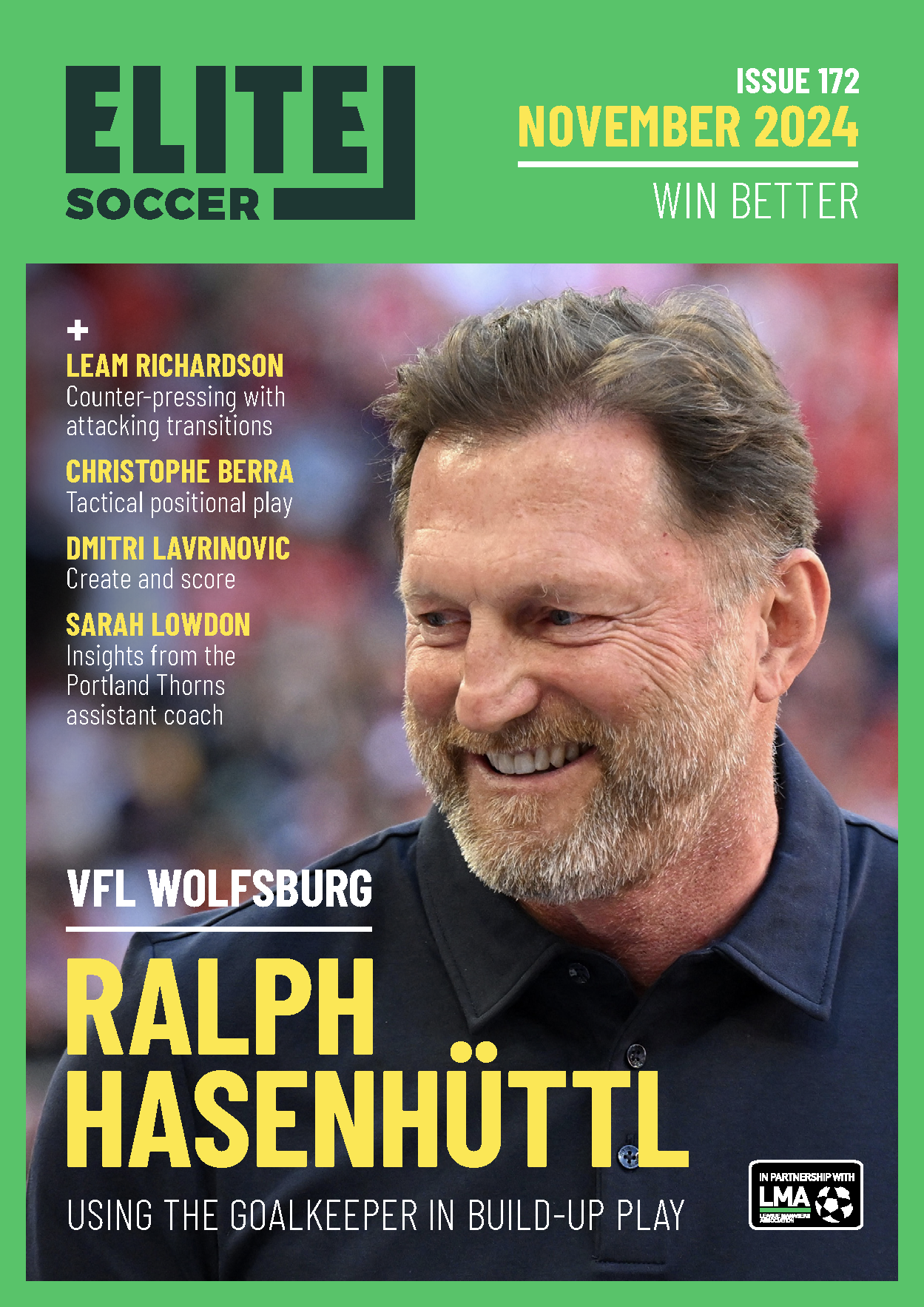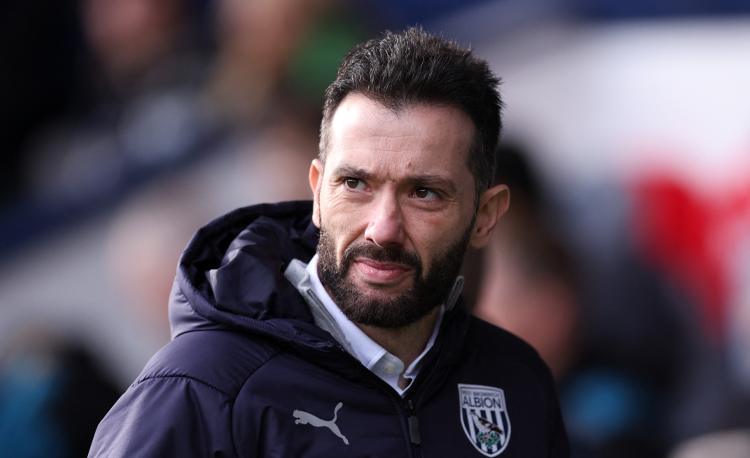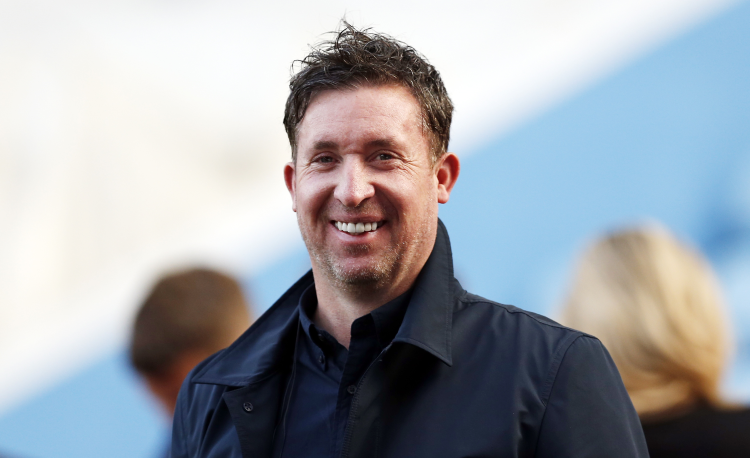You are viewing 1 of your 1 free articles
Turning to play forward
This exclusive session from Sean Dyche aims to encourage turning to open the opportunity to play forward rather than sending the ball sideways or backwards. Within this, it allows players to put the ball ‘at risk’.
| Area | Up to 40x20 yards |
| Equipment | Balls, cones, goals |
| No. of Players | Up to 7v7 |
| Session Time | 90-second bursts for 4-6mins |
This session aims to encourage turning to open the opportunity to play forward rather than sending the ball sideways or backwards.
Within this, it allows players to put the ball ‘at risk’. We all know that keeping possession is very important, but it has to be productive, and coaching players to be brave in possession is very important. Turning under pressure then looking to play forward puts opponents on the back foot so encouraging players to put the ball at risk also helps them along the way to playing with freedom.
This is a generic session that can be used to teach individual players or to enhance teams’ productivity and, from that, the team’s ability to penetrate the opposition. It can also be used for football fitness, if and when appropriate.
What do I get the players to do?
Possession groups
The session starts simply and in small groups. Setting up as shown (1), each team in possession looks to play with the outside reds in order to switch the play by turning under pressure, while the aim of team mates is to lose their marker and rotate, then receive from the reds.
1

2. The ball is received and passed on
3. Playing on the turn, this man opens up his body to receive the ball whilst protecting it from his blue marker
4. The other opposite target man receives the pass and a point is scored
5. The move immediately restarts with an attack towards the other end
6. A third grey waits on the outside so we can quickly rotate teams at the end of each 90-second burst
We would start this all-in. Then, as players progress (up to first team level), we can adapt it to be three-touch. Each time a team plays from one end to the other, whilst incorporating a turn, a point is scored.
We will rotate the three teams in 90-second bursts.
How do I progress the session?
To take the practice forward we can increase the size of the playing area and add a mini-goal (or mini-goals) at each end, as shown on a 40x20-yard area (2).
2
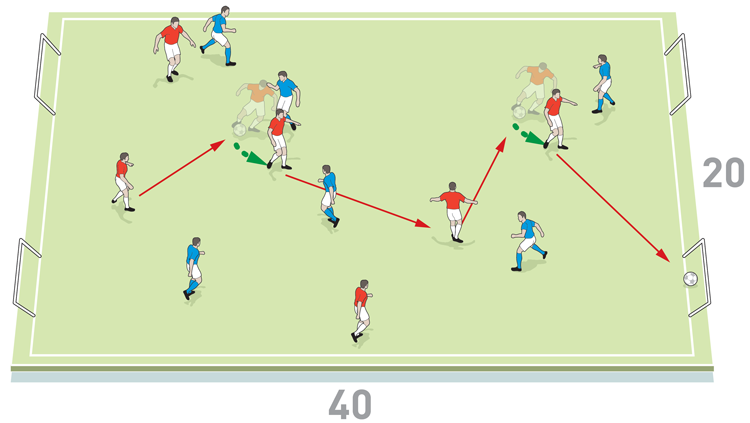
We can also look at changing player numbers or splitting the practice area into definitive areas, as shown (3). For instance, overloading the middle section - even in a 50x30-yard area - so it is tight, with players having to work hard to be technically bright in finding space, is always a useful step forward. We would recommend leaving 3v2 in favour of the defender to allow the first pass into midfield, ensuring that the drill can start with quality.
3
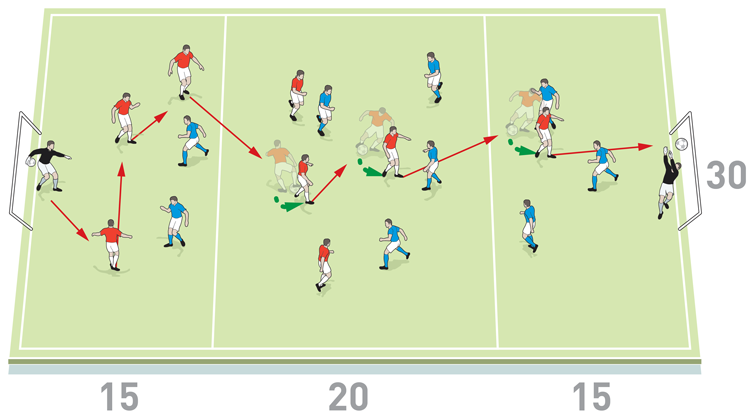
To further progress, one of the attacking players can move into the next zone, but only once a player has turned in the middle area.
It should be noted, the sizes of the areas are adaptable to the standard of players. These drills are in ‘tight areas’ due to the quality of our players but if working with less technical or younger players we then adjust the size to suit accordingly.
What are the key things to look out for?
Technically we are looking for players to check over their shoulders before receiving. We also want to see receiving on the back foot and a soft touch on the ball.
Tactically it’s all about the importance of how turning affects opponents, and in those turns, opening up ‘the picture’.
Typical mistakes include not checking over the shoulder, and from that, players finding themselves being dispossessed. We also want to rule out poor technique, so concentration and application levels must be high, and players not willing to try ‘risk football’ should be picked up on the fact they are playing too safe.
How do I put this into a game situation?
By removing the flat discs and sections of the pitch we can turn this into a generic small-sided game, but with the ruling that it’s only one-touch to play sideways and backwards, but four touches if a player turns and play forwards.
Related Files
Editor's Picks
Using the goalkeeper in build-up play
Pressing principles
Intensive boxes drill with goals
Penetrating the final third
Creating and finishing
My philosophy
Pressing initiation
Compact team movement
Defensive organisation
Coaches' Testimonials

Alan Pardew

Arsène Wenger

Brendan Rodgers

Carlos Carvalhal

José Mourinho

Jürgen Klopp

Pep Guardiola

Roy Hodgson

Sir Alex Ferguson

Steven Gerrard
Related
Coaches' Testimonials

Gerald Kearney, Downtown Las Vegas Soccer Club

Paul Butler, Florida, USA

Rick Shields, Springboro, USA

Tony Green, Pierrefonds Titans, Quebec, Canada
Join the world's leading coaches and managers and discover for yourself one of the best kept secrets in coaching. No other training tool on the planet is written or read by the calibre of names you’ll find in Elite Soccer.
In a recent survey 92% of subscribers said Elite Soccer makes them more confident, 89% said it makes them a more effective coach and 91% said it makes them more inspired.
Get Monthly Inspiration
All the latest techniques and approaches
Since 2010 Elite Soccer has given subscribers exclusive insight into the training ground practices of the world’s best coaches. Published in partnership with the League Managers Association we have unparalleled access to the leading lights in the English leagues, as well as a host of international managers.
Elite Soccer exclusively features sessions written by the coaches themselves. There are no observed sessions and no sessions “in the style of”, just first-hand advice delivered direct to you from the coach.



